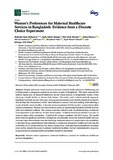Women’s preferences for maternal healthcare services in Bangladesh: Evidence from a discrete choice experiment.

View/
Date
2019-01-23Publisher
MDPIAuthor
Mahumud, Rashidul AlamAlamgir, Nadia Ishrat
Hossain, Md. Tarek
Baruwa, Elaine
Sultana, Marufa
Gow, Jeff
Alam, Khorshed
Ahmed, Syed Masud
Khan, Jahangir A.M.
Metadata
Show full item recordCitation
Mahumud, R. A., Alamgir, N. I., Hossain, M. T., Baruwa, E., Sultana, M., Gow, J., . . . Khan, J. A. M. (2019). Women’s preferences for maternal healthcare services in Bangladesh: Evidence from a discrete choice experiment. Journal of Clinical Medicine, 8(2) doi:10.3390/jcm8020132Abstract
Despite substantial improvements in several maternal health indicators, childbearing and
birthing remain a dangerous experience for many women in Bangladesh. This study assessed the
relative importance of maternal healthcare service characteristics to Bangladeshi women when
choosing a health facility to deliver their babies. The study used a mixed-methods approach.
Qualitative methods (expert interviews, focus group discussions) were initially employed to identify
and develop the characteristics which most influence a women’s decision making when selecting a
maternal health service facility. A discrete choice experiment (DCE) was then constructed to elicit
women’s preferences. Women were shown choice scenarios representing hypothetical health facilities
with nine attributes outlined. The women were then asked to rank the attributes they considered
most important in the delivery of their future babies. A Hierarchical Bayes method was used to
measure mean utility parameters. A total of 601 women completed the DCE survey. The model
demonstrated significant predictive strength for actual facility choice for maternal health services.
The most important attributes were the following: consistent access to a female doctor, the availability
of branded drugs, respectful provider attitudes, a continuum of maternal healthcare including the
availability of a C-section delivery and lesser waiting times. Attended maternal healthcare utilisation
rates are low despite the access to primary healthcare facilities. Further implementation of quality
improvements in maternal healthcare facilities should be prioritised.
